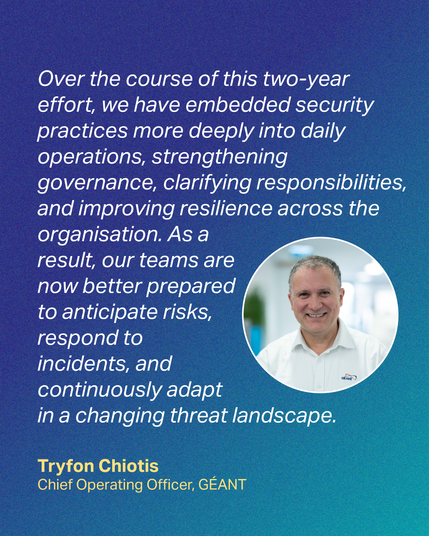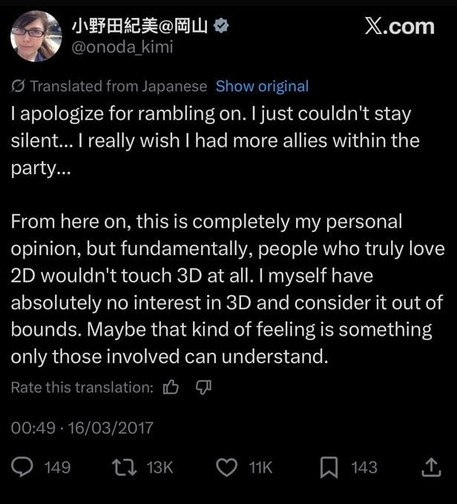2025-09-15 12:06:31
🔐 GÉANT is now ISO 27001 certified!
This achievement shows that our information security practices meet the highest international standards—supporting secure collaboration and compliance across Europe’s Research & Education community.
👏 A big thank you to everyone involved in this effort—and to our GÉANT community, who rely on trust and security to collaborate cross-border, every day.
🔗 Read more:
2025-12-13 15:49:09
Just finished "Endgames" by Ru Xu, sequel to "Newsprints." I was happy to see the characters from the first book get their endings, but Xu feels incredibly out of her depth writing about the politics of empire and the power/complicity of the press, which completely dampened my enjoyment.
As just one example, there's a ton of interesting nuance to explore behind the idea of a disabled imperial ruler and how disadvantage/persecution (from which you have been effectively shielded) does not justify harming others. This book explores none of that.
I think it does serve as a great example of how severely one limits one's own imagination when one buys into the myth of nationhood as natural/inevitable/good. It's not that Xu's politics are especially authoritarian, I think, but that she's just (been kept?) resoundingly naïve, and so her plot resolution feels childish (or perhaps that's an insult to children).
#AmReading #ReadingNow
2025-12-10 14:39:26
2025-12-06 13:33:51
The thing about a life-logger, is you input sensitive data about your life, lifestyle and activities, so privacy and data-integrity are some of the most important issues.
There can be no server, the data has to be yours and yours alone. Because you can’t tell what is happening to the data in a closed-source app, it must be completely free and open source.
You can’t trust a corporate diary, they must sell to anyone offering enough money.
So it is with my life log app, all data completely in your own device. No home server ever sees anything.
There is no home server. Just the code.
To achieve this Exocortex Log is a Progressive Web App. It downloads when you are online at the website and can be installed onto the homepage of your phone.
It keeps all data on the local device using indexdb.
This means you must be responsible for your own backups. Be sure to export and back up your data regularly. I have gaps in my ten year record where my phone was stolen and most recent backup was months prior.
Once installed it will work offline, airplane mode, no internet, down in the tube station at midnight, anywhere.
There's a blog on the website saying this and more: https://exocortexlog.com/news/articles/2025-12-06-release/
2025-10-28 23:44:58
Do you have the ability to write code for Apple platforms? Do you know what MDM / device management is? Do you understand what Compliance is? Do you care about being able to use a Mac or iPad or iPhone for work or school?
Does the idea of dealing with the bugs that can crop up from things like "this needs to be reliably managed like a server, but a human randomly sleeps it mid-process and when it wakes up it's in a different country!" sound interesting to you?
If so - come be my direct co-worker!
Need to be able to be based in/work within the US, but the team itself is fully remote. Multiple positions open.
Feel free to DM me with questions
https://jobs.apple.com/en-us/details/200628824-0836/software-engineer-test-infrastructure
2025-10-24 13:52:52
Day 28: Samira Ahmed
As foreshadowed, we're back to YA land, which represents a lot of what I've been enjoying from the library lately.
I've read "Hollow Fires", "This Book Won't Burn", and "Love, Hate, and other Filters" by Ahmed, along with "Mad, Bad, and Dangerous to Know" which is quite different. All four are teen ~romances with interesting things to say about racism & growing up as a South Asian Muslim, but whereas the first three are set in small-town Indiana, the third is set in France and includes a historical fiction angle involving Dumas and a hypothetical Muslim woman who was (in this telling) the inspiration for several Lord Byron poems.
Ahmed's novels all include a strong and overt theme of social justice, and it's refreshing to see an author not try to wade around the topic or ignore it. Her romances are complex, with imperfect protagonists and endings that aren't always "happily ever after" although they're satisfying and believable.
My library has a plethora of similar authors I've been enjoying, including Adiba Jaigirdar (who appeared earlier in this list), Sabaa Tahir ("All my Rage" is fantastic but I'm less of a fan of her fantasy stuff), Sabina Khan ("The Love and Lies of Rukhsana Ali"), and Randa Abdel-Fattah ("Does My Head Look Big In This?"; from an earlier era). Ahmed gets the spot here because I really like her politics and the way she works them into her writing. Her characters are unapologetic advocates against things like book bans, and Ahmed doesn't second-guess them or try to make things more palatable for those who want to ban books (or whatever). Her historical fiction in "Mad..." is also really cool in terms of "huh that could actually totally be true" and grappling with literary sexism from ages past.
#30AuthorsNoMen
2025-11-23 11:34:44
2025-11-19 06:07:23
Part of why #Trump has always been so hard to pin down politically is that he was always representing highly conflicting interests. Now, as that eats him alive, the GOP is fracturing in to two main groups: the Pinochet/Franco wing and the Hitler wing.
The Pinochet/Franco wing (let's call them PF) are lead by Vance. PF are also a coalition with some competing interests, but basically it's evangelical leaders, Opus Dei (fascist catholics), tech fascists (Yarvinites), pharma, and the other normal big republican donors. They support Israel, some because apartheid is extremely profitable and some because they support the genocide of Palestinian in order to bring the end of the world. They are split between extremely antisemitic evangelicals and Zionists, wanting similar things for completely different reasons. PF wants strong immigration enforcement because it lets them exploit immigrants, they don't want actual ethnic cleansing (just the constant threat). They want H1B visas because they want to a precarious tech work force. They want to end tariffs because they support free trade and don't actually care about things being made here.
The Hitler wing are lead by Nick Fuentes. I think they're a more unified group, but they're going to try to pull together a coalition that I don't think can really work. They're against Israel because they believe in some bat shit antisemitic conspiracy theory (which they are trying to inject along side legitimate criticism of Israel). They are focused on release of the #EpsteinFiles because they believe that it shows that Epstein worked for Mossad. They don't think that the ICE raids are going far enough, they oppose H1Bs because they are racists. They want a full ethnic cleansing of the US where everyone who isn't "white" is either enslaved for menial labor, deported, or dead. But they're also critical of big business (partially because of conspiracy theories but also) because they think their best option is to push for a white socialism (red/brown alliance).
Both of them want to sink Trump because they see him as standing in the way of their objectives. Both see #Epstein as an opportunity. Both of them have absolutely terrifying visions of authoritarian dictatorships, but they're different dictatorships.with opposing interests. Even within these there may be opportunities to fracture these more.
While these fractures decrease the likelihood of either group getting enough people together, their vision is more clear and thus more likely to succeed if they can make that happen. Now is absolutely *not* the time to just enjoy the collapse, we need to keep up or accelerate anti-fascist efforts to avoid repeating some of the mistakes of history.
Edit:
I should not that this isn't *totally* original analysis. I'll link a video later when I have time to find it.
Here it is:
#USPol







